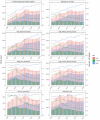Analysis and projections of disease burden for different risk factors and sexes of ischemic stroke in young adults in China
- PMID: 38858463
- PMCID: PMC11164860
- DOI: 10.1038/s41598-024-63920-0
Analysis and projections of disease burden for different risk factors and sexes of ischemic stroke in young adults in China
Abstract
To estimate the rate of death, and disability-adjusted life years (DALYs) and project the disease burden of ischemic stroke due to relevant risk factors in young adults age 20-49 years by sex in China. Data from the Global Burden of Diseases, Injuries, and Risk Factors Study (GBD) 2019 were used. The age-standardized mortality (ASMR), age-standardized DALYs rate (ASDR), and estimated annual percentage changes (EAPC) were calculated to evaluate the temporal trends from 1990 to 2019. We also used the NORDPRED model to predict ASMR for ischemic stroke due to related risk factors in Chinese young adults over the next 10 years. From 1990 to 2019, the general age-standardized mortality [from 2.39 (1.97 to 2.99) in 1990 to 1.8 (1.41 to 2.18) in 2019, EAPC = - 1.23] and DALYs rates (from 171.7 (140.34 to 212.36) in 1990 to 144.4 (114.29 to 177.37) in 2019, EAPC = - 0.86) decreased for ischemic stroke in young adults in China. ASMR and ASDR decreased for all level 1 risk factors (including behavioral, environmental/occupational, and metabolic) from 1990 to 2019, with the slightest decrease for metabolic risks [ASMR from 1.86 (1.39 to 2.41) in 1990 to 1.53 (1.15 to 1.92) in 2019, ASDR from 133.68 (99.96 to 173.89) in 1990 to 123.54 (92.96 to 156.98) in 2019] and the largest decrease for environmental/occupational risks [ASMR from 1.57 (1.26 to 1.98) in 1990 to 1.03 (0.78 to 1.29) in 2019, ASDR from 110.91 (88.44 to 138.34) in 1990 to 80.03 (61.87 to 100.33) in 2019]. In general, high body-mass index, high red meat intake, and ambient particulate matter pollution contributed to the large increase in ASMR and ASDR between 1990 and 2019. Significant reductions in ASMR and ASDR were observed in low vegetables intake, household air pollution from solid fuels, lead exposure, and low fiber intake. In addition, there were sex differences in the ranking of ASMR attributable to risks in ischemic stroke. The disease burden of ischemic stroke attributable to relevant risk factors in young adults in China is greater and has a faster growth trend or a slower decline trend in males than in females (except for secondhand smoke). The apparent increasing trend of ASMR attributable to high fasting plasma glucose, high systolic blood pressure, high body-mass index, and high red meat intake was observed in males but not in females. The projected analysis showed an increasing trend in ASMR between 1990 and 2030 for all specific metabolic risks for males, but a decreasing trend for females. ASMR attributable to ambient particulate matter pollution showed an increasing trend from 1990 to 2030 for both males and females. The burden of ischemic stroke in young adults in China showed a downward trend from 1990 to 2019. Specific risk factors associated with the burden of ischemic stroke varied between the sexes. Corresponding measures need to be developed in China to reduce the disease burden of ischemic stroke among young adults.
Keywords: Ischemic stroke; Metabolic risk factors; Risk factors; The Global Burden of Disease; Young adults.
© 2024. The Author(s).
Conflict of interest statement
The authors declare no competing interests.
Figures




Similar articles
-
Temporal trends of the burden of ischemic stroke attributable to high low-density lipoprotein cholesterol in China from 1999 to 2019.BMC Public Health. 2024 Oct 30;24(1):3003. doi: 10.1186/s12889-024-20461-5. BMC Public Health. 2024. PMID: 39478553 Free PMC article.
-
Burden of uterine cancer in China from 1990 to 2021 and 15-year projection: a systematic analysis and comparison with global levels.Reprod Health. 2024 Oct 10;21(1):144. doi: 10.1186/s12978-024-01882-2. Reprod Health. 2024. PMID: 39390595 Free PMC article.
-
Spatiotemporal trends in stroke burden and mortality attributable to household air pollution from solid fuels in 204 countries and territories from 1990 to 2019.Sci Total Environ. 2021 Jun 25;775:145839. doi: 10.1016/j.scitotenv.2021.145839. Epub 2021 Feb 13. Sci Total Environ. 2021. PMID: 33631580
-
Global burden, risk factors, and projections of early-onset dementia: Insights from the Global Burden of Disease Study 2021.Ageing Res Rev. 2025 Feb;104:102644. doi: 10.1016/j.arr.2024.102644. Epub 2024 Dec 17. Ageing Res Rev. 2025. PMID: 39701185 Review.
-
The incidence, mortality and disease burden of cardiovascular diseases in China: a comparative study with the United States and Japan based on the GBD 2019 time trend analysis.Front Cardiovasc Med. 2024 Sep 18;11:1408487. doi: 10.3389/fcvm.2024.1408487. eCollection 2024. Front Cardiovasc Med. 2024. PMID: 39359640 Free PMC article. Review.
Cited by
-
Global, regional, and national epidemiology of ischemic stroke in young adults, 1990-2021.J Neurol. 2025 Apr 22;272(5):354. doi: 10.1007/s00415-025-13082-4. J Neurol. 2025. PMID: 40261367
-
An analysis of trends in the burden of ischemic stroke caused by air pollution in China between 1990 and 2021.BMC Public Health. 2025 Apr 28;25(1):1567. doi: 10.1186/s12889-025-22287-1. BMC Public Health. 2025. PMID: 40296073 Free PMC article.
-
The global, regional, and national prostate cancer burden and trends from 1990 to 2021, results from the global burden of disease study 2021.Front Public Health. 2025 May 21;13:1553747. doi: 10.3389/fpubh.2025.1553747. eCollection 2025. Front Public Health. 2025. PMID: 40469596 Free PMC article.
-
Temporal trends and epidemiological impact of metabolic risk factors on stroke burden in Chinese individuals aged 65 and older, 1992-2021.Front Neurol. 2025 Jul 29;16:1607823. doi: 10.3389/fneur.2025.1607823. eCollection 2025. Front Neurol. 2025. PMID: 40800686 Free PMC article.
-
Status and influencing factors of pre-hospital delay in young and middle-aged Chinese patients with acute ischemic stroke.Front Public Health. 2025 Jun 4;13:1539219. doi: 10.3389/fpubh.2025.1539219. eCollection 2025. Front Public Health. 2025. PMID: 40535448 Free PMC article.
References
MeSH terms
Grants and funding
LinkOut - more resources
Full Text Sources
Medical

